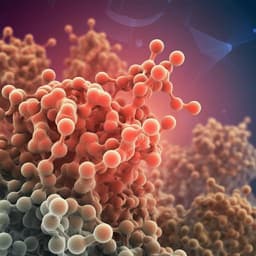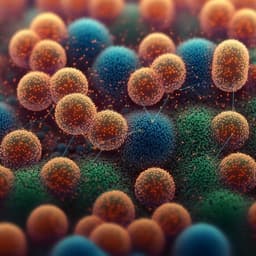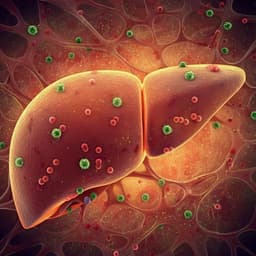
Medicine and Health
Gut microbiota link dietary fiber intake and short-chain fatty acid metabolism with eating behavior
E. Medawar, S. Haange, et al.
This groundbreaking study by authors including Evelyn Medawar and Sven-Bastiaan Haange explores how gut microbiota, dietary fiber intake, and short-chain fatty acid metabolism are intertwined with eating behaviors in adults. Discover how these elements might influence weight status and treatment responses in those with obesity, emphasizing the vital role of gut health in our dietary choices.
~3 min • Beginner • English
Introduction
Background: Gut microbes can influence brain function and behavior through immune, endocrine, neural, and humoral pathways, potentially affecting feeding circuits and overeating. Dysbiosis has been observed in psychiatric eating disorders and obesity. Prior human and animal studies suggest that microbiota composition can influence weight loss and metabolic outcomes, and that dietary composition can shape the microbiota and predict responses to diet. SCFAs produced by gut bacteria from dietary fibers modulate appetite-related hormones (PYY, GLP-1) and may signal to the brain, potentially influencing appetite and food decisions. Research question: The study asked whether gut microbial diversity and specific genera abundances relate to eating behavior and to SCFA metabolites in feces and serum in young overweight adults. Additionally, it tested whether the abundance of eating-related microbiota correlates with weight status, eating behavior, and treatment success (weight loss) in patients two years after RYGB compared to BMI-matched controls. Purpose and importance: To identify microbiota genera linked to eating behavior and metabolic markers in humans, and to explore diet (fiber) and SCFA metabolism as potential modifiers of these relationships, informing targets for future interventional studies.
Literature Review
The authors summarize evidence that bariatric surgery induces lasting changes in gut microbiota (e.g., increased Escherichia and Akkermansia; altered Bacteroides/Prevotella ratios; decreased Firmicutes or increased Gammaproteobacteria). Baseline microbiota profiles (e.g., Bacteroides-to-Prevotella ratio) can predict dietary weight loss, and microbial composition predicts glycemic responses to foods. Human-to-mouse fecal transplant studies demonstrate causal roles of microbiota in weight regulation, while human FMT can improve insulin sensitivity. Autologous FMT from periods of weight loss has been shown to prevent weight regain. Mechanistically, SCFAs produced by fermentation of dietary fibers stimulate anorexigenic hormones (PYY, GLP-1) and may directly affect brain signaling. Intake of butyrate or butyrate-producing bacteria can influence body weight and food intake. Diet is a potent modulator of SCFA-producing bacteria. Despite these advances, specific links between human eating behavior, diet, SCFA, and particular genera remain limited, motivating the current study.
Methodology
Design: Exploratory cross-sectional analyses of two independent human cohorts with microbiota profiling and behavioral/metabolic assessments. Sample 1: 27 healthy young overweight adults (9 female), 21–36 years, BMI 25–31 kg/m², omnivorous Western diet, with exclusion of restrictive diets, high caffeine/alcohol intake, and heavy smoking. Available measures: fecal microbiota (16S rRNA), fecal and serum SCFA, dietary fiber intake (g/day and per 1000 kcal), hunger ratings after a standardized meal, eating behavior (TFE-Q), anthropometrics (body fat %, systolic blood pressure). Sample 2: 23 patients ≥2 years post-RYGB classified as good responders (n=11) or bad responders (n=12) based on excessive weight loss (EWL >70% vs <40%), plus BMI-, age-, and sex-matched overweight (n=8) and obese controls (n=9). Measures: microbiota genera abundances (16S rRNA), eating behavior (EDE-Q), and post-surgery weight loss (kg and BMI). Microbiota assessment: Fecal DNA extraction, V3–V4 16S rRNA amplification, paired-end 2×250 bp Illumina sequencing (GENEWIZ). Processing via DADA2 to obtain ASVs; taxonomy assigned using RDP database; relative abundances calculated with Rhea; visualization in R (ggplot2). Diversity: Shannon effective index computed. Eating behavior questionnaires: Sample 1 used TFE-Q (cognitive restraint, disinhibition, hunger). Sample 2 used EDE-Q (dietary restraint, eating concern, weight concern, shape concern). Hunger ratings: multiple postprandial time points after a standardized meal. Dietary fiber: quantitative food frequency questionnaire (FFQ), expressed in g/day and g/1000 kcal. SCFA quantification: LC-MS-based method per Han et al. (2015) measuring acetate, butyrate, propionate in serum (fasted) and feces; serum processed at 12±3 h fasting, stored at −80 °C. Statistics: For main analysis, 20 genera present in ≥80% of individuals were correlated with variables in sample 1 (Shannon index, TFE-Q traits, hunger ratings, body fat %, systolic BP, fiber intake metrics, fecal and serum SCFAs). Non-normal variables log or Tukey-transformed (skewness <1). Correlations used Pearson or Spearman as appropriate; FDR correction applied (p<0.05 significant). Composite genera sumscores constructed: positive (sum of 7 health-related genera), negative (sum of 5 inversely health-related genera), and composite (positive minus negative). Mediation analyses (R medmod) tested specified paths: fiber → genera/sumscores; eating behavior → fiber → genera/sumscores; genera/sumscores → SCFA → eating behavior. Group differences in sample 2 analyzed via Kruskal–Wallis tests; correlations assessed within groups. Exploratory analyses adjusted for potential confounders including body fat mass; examined effects of time of day, seasonality, and coffee intake on alpha diversity. Ethics: Sample 1 registered NCT03829189 (ethics 228/18-ek); Sample 2 ethics 027/17-ek.
Key Findings
- In sample 1 (young overweight adults): Alpha diversity showed minimal associations with eating behavior, except higher diversity correlated with higher postprandial hunger (≈10 min; r=0.59, p=0.005). - Twelve genera related to eating behavior after FDR correction (|r|>0.4): • Health-related (higher abundance associated with healthier eating traits/lower hunger): Alistipes, Blautia, Clostridium XVIII, Gemmiger, Roseburia, Ruminococcus, Streptococcus (all r between 0.42 and 0.76, p-FDR<0.05). • Inversely health-related (higher abundance associated with unhealthier eating traits/higher hunger): Clostridium IV, Clostridium XIVb, Collinsella, Fusicatenibacter, Parabacteroides (|r| between 0.42 and 0.61, p-FDR<0.05). - Health indicators: Collinsella correlated with higher body fat mass (sex-standardized, r=0.61, p<0.001). Streptococcus correlated with lower mean systolic blood pressure (r=−0.70, p-FDR<0.001). - Dietary fiber: Among the 12 eating-related genera, Collinsella and Parabacteroides associated with lower fiber intake, while Clostridium XVIII associated with higher fiber intake (0.49<|r|<0.73, p-FDR<0.05). Higher fiber intake associated with lower TFE-Q disinhibition (r=0.58, p-FDR<0.01) and lower body fat mass (r=−0.75, p-FDR<0.0001). - SCFA profiles: Fecal SCFA levels were ~1000× higher than serum for acetate, butyrate, propionate (all t(24)>11.6, p<0.001). Serum acetate was ~2.5× higher than serum butyrate and propionate. Serum and fecal SCFA were uncorrelated (all r<0.17, p-uncorr>0.86). Several inversely health-related genera correlated with higher fecal/serum SCFA (r>0.50, p-FDR<0.01). Fusicatenibacter correlated with fecal propionate; Parabacteroides with fecal acetate. Higher fecal propionate associated with higher cognitive restraint (r=0.50, p-FDR=0.014). Higher fecal acetate, butyrate, propionate associated with higher hunger ratings (all r>0.45, p-FDR<0.04). Serum acetate and butyrate inversely associated with body fat mass (all r>−0.43, p-FDR<0.04). - Genera sumscores: Negative sumscore (sum of 5 inversely health-related genera) correlated with TFE-Q cognitive restraint (r=0.59, p-uncorr=0.001) and disinhibition (r=0.65, p-uncorr<0.001); positive sumscore showed no significant associations. - Mediation: No significant mediation for most paths; however, Parabacteroides abundance was linked to higher postprandial hunger via higher fecal acetate (indirect effect a*b: B=0.36, 95% CI [0.05, 0.66], p=0.02; direct effect not significant). - In sample 2 (RYGB and controls): Two of five inversely health-related genera differed between groups (H(3)>9.5, p<0.023). Parabacteroides was lower in good vs bad RYGB responders (H(1)=4.9, p=0.027). Six of seven health-related genera were more abundant in the overweight control group (H(3)>8.3, p<0.036), with no significant differences between good vs bad RYGB responders. Both positive and negative sumscores differed across groups (H(3)>11.3, p<0.01); the negative sumscore was higher in bad vs good RYGB responders (H(1)=2.1, p=0.036) and tended to be higher in overweight vs obese. - Eating behavior and weight loss in RYGB groups: Bad responders showed higher EDE-Q restraint (H=5.3, p=0.022). Parabacteroides abundance correlated with higher restraint (r=0.44, p=0.039) and inversely with weight loss after surgery (r=0.49, p=0.019, n=20). The negative sumscore correlated with unhealthier EDE-Q profile (mean subscales r=0.47, p=0.027; restraint r=0.49, p=0.022) and with less post-surgery weight loss (weight r=0.53, p=0.011; BMI r=0.53, p=0.011). - Exploratory adjustments: Adjusting for body fat mass attenuated several associations, particularly for health-related genera; many associations with inversely health-related genera remained significant. Potential confounders (time of day, seasonality, coffee intake) showed no significant effects on alpha diversity.
Discussion
The study identified two clusters of gut genera associated with eating behavior and anthropometric measures: a set of presumably beneficial, fiber- and SCFA-linked genera (e.g., Alistipes, Blautia, Roseburia, Ruminococcus) related to healthier eating traits, and a set of inversely health-related genera (e.g., Collinsella, Parabacteroides, Clostridium IV/XIVb, Fusicatenibacter) related to unhealthier eating traits and higher hunger. Findings were replicated in part across an independent clinical cohort by linking Parabacteroides abundance and a negative genera sumscore to poorer long-term weight loss after RYGB and more disordered eating traits. Diet and SCFA metabolism appear to modify these relationships: higher habitual fiber intake associated with beneficial genera, healthier eating traits, and lower adiposity, whereas specific inversely health-related genera related to higher fecal SCFA (acetate, propionate) that correlated with elevated hunger. Serum SCFA associations with lower body fat suggest complex compartment-specific SCFA dynamics. The results support a model in which diet shapes gut microbiota, which in turn modulates host appetite regulation and weight status via SCFA-related mechanisms and possibly other pathways (gut hormones, vagal signaling). Body fat mass emerged as an important covariate influencing some microbiome–behavior associations. While causality cannot be inferred, the converging patterns across two samples highlight candidate genera—particularly Parabacteroides—as potential biomarkers or targets for interventions aimed at improving eating behavior and weight outcomes.
Conclusion
Across two cross-sectional cohorts (young overweight adults and post-RYGB patients with controls), specific gut bacterial genera were associated with eating behavior, dietary fiber intake, SCFA profiles, and weight status. Beneficial SCFA-producing and fiber-degrading genera correlated with healthier eating traits, whereas genera including Parabacteroides and Collinsella correlated with unhealthier eating traits, higher hunger, and poorer weight loss outcomes after RYGB. Dietary fiber and SCFA metabolism likely modulate these relationships. These findings generate hypotheses for diet–microbiome–brain interactions that could inform strategies to prevent or treat unhealthy food cravings and obesity. Future work should employ longitudinal and randomized interventional designs, species- and pathway-level metagenomics, targeted manipulation (e.g., prebiotics/probiotics), and comprehensive phenotyping to test causality and mechanism.
Limitations
- Cross-sectional design precludes causal inference. - Small sample sizes relative to the number of variables limited statistical power and complexity of modeling (e.g., no structural equation modeling). - Serum and fecal samples were not time-locked; rapid SCFA metabolism and diurnal variation may have obscured associations between compartments. - Mediation analyses were exploratory and not adjusted for multiple testing, increasing false-positive risk. - Body fat mass variability influenced several associations; other potential confounders (e.g., medications) were not fully assessed. - 16S rRNA profiling limits taxonomic resolution; genera are heterogeneous, and some taxa may be misclassified; species-level and functional insights are lacking.
Related Publications
Explore these studies to deepen your understanding of the subject.







